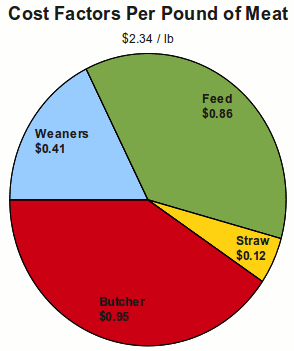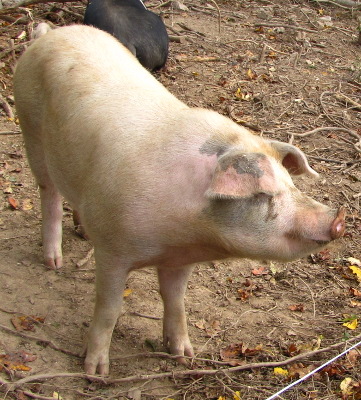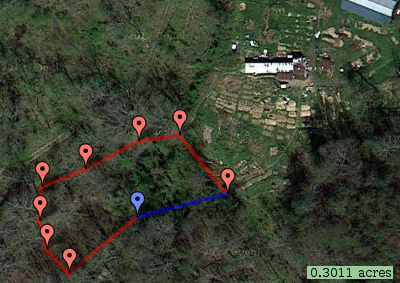
Pondering pigs
 Long-time readers will be
aware that I'm always trying to sneak new livestock onto the farm and
Mark's always reining me in. "Whoa, there!" he says. "Are
you ready for such a big commitment? Remember how much time the
garden and fruit trees and berry bushes and laying flock and broilers
take up, not to mention all this writing you're always poking away
at. Do you really think we have time to milk
a goat or fence
in an acre for sheep?"
Long-time readers will be
aware that I'm always trying to sneak new livestock onto the farm and
Mark's always reining me in. "Whoa, there!" he says. "Are
you ready for such a big commitment? Remember how much time the
garden and fruit trees and berry bushes and laying flock and broilers
take up, not to mention all this writing you're always poking away
at. Do you really think we have time to milk
a goat or fence
in an acre for sheep?"
I think I may have found
the perfect middle ground, though --- fattening a pair of hogs. This
fascinating page
suggests that you can raise a pair of pigs from 40 pounds (when they're
weaned) to 200 pounds for $500 ($1.39 per pound) if you do the
butchering yourself. The great part is that the whole process
only takes four months, so if we decide we hate swine, we only have to
live with them for 120 days.
 (Even if we weren't pinching
pennies, we'd have to do the butchering on-farm. The idea of
walking a pig half a mile down our floodplain to the parking area and
then loading it up in our car to get to the slaughter-house sounds
tougher than skinning, gutting, and cleaning the hogs ourselves.
Bradley remembers killing hogs with his family as a kid, so I'll bet we
could get him to help us, and how much harder could it be than a deer?)
(Even if we weren't pinching
pennies, we'd have to do the butchering on-farm. The idea of
walking a pig half a mile down our floodplain to the parking area and
then loading it up in our car to get to the slaughter-house sounds
tougher than skinning, gutting, and cleaning the hogs ourselves.
Bradley remembers killing hogs with his family as a kid, so I'll bet we
could get him to help us, and how much harder could it be than a deer?)
In addition to providing
top-notch meat for $1.39 per pound, spending the summer with a pair of
pigs could be the first step toward reclaiming more quality pasture for
chickens (or other animals). As colonizing
livestock, pigs can
be living bush hogs if you leave the rings out of their noses, and all
of the areas we've considered expanding into would need a year or two
of this work before anything else could happen there.
As an added bonus,
there's always the
manure to
consider. Plus, increased diversity on a homestead usually seems
to lead to increased efficiency, in this case resulting from the pigs
eating some garden waste the chickens aren't interested in. And I
just love experimenting with new things.
 My
reading suggests that a third of an acre divided into four paddocks
would be sufficient pasture for a pair of growing swine. I've got
the perfect spot in mind too --- a little plateau just southwest of our
core homestead with lots of scrubby growth that can come out and two
big oak trees that would stay put and drop mast (acorns) into the
pasture. The question is, how crazy am I to want to spend $1,550
on a livestock panel fence that will last the rest of our lives and
allow us to graze anything we want in there forever, versus a small
fraction of that sum on electric fencing?
My
reading suggests that a third of an acre divided into four paddocks
would be sufficient pasture for a pair of growing swine. I've got
the perfect spot in mind too --- a little plateau just southwest of our
core homestead with lots of scrubby growth that can come out and two
big oak trees that would stay put and drop mast (acorns) into the
pasture. The question is, how crazy am I to want to spend $1,550
on a livestock panel fence that will last the rest of our lives and
allow us to graze anything we want in there forever, versus a small
fraction of that sum on electric fencing?
And, of course, is
raising a pair of weanling pigs much more work than I imagine?
I'd be curious to hear from others who have tried a similar small-scale
operation. If we figured out the fencing and housing over the
winter, would day-to-day pig care drive me nuts during the busy garden
season?
(What do you think,
Mark? Are you sold?)
Want more in-depth information? Browse through our books.
Or explore more posts by date or by subject.
About us: Anna Hess and Mark Hamilton spent over a decade living self-sufficiently in the mountains of Virginia before moving north to start over from scratch in the foothills of Ohio. They've experimented with permaculture, no-till gardening, trailersteading, home-based microbusinesses and much more, writing about their adventures in both blogs and books.
Want to be notified when new comments are posted on this page? Click on the RSS button after you add a comment to subscribe to the comment feed, or simply check the box beside "email replies to me" while writing your comment.

This was our first year at raising pigs. We raised 2 from about 45 lbs to around 200-230 lbs. 1 boar and 1 gilt. They are great animals to be around. Ours were never aggressive as some people had warned me. The cost you show are very close to ours but we had ours processed off site. I created a movable pen out of some hog panels and connected them with carabiners and used metal garden T posts to keep the pen on the ground. We moved it weekly. This year we will be running some electric wire stands through our woods with about 6 or so paddock areas to rotate them through. We plan to raise 2 for ourselves again and maybe 2 to sell. I think we will try to do the processing on site this time.
I'm glad we took the plunge and gave it a try. I thought it might be too much for us. It is a bit of a step up from our chickens. But we made it, learned a lot, and now have a freezer full of pork. Good luck!
Michael and Neville, owners of Woods Hole Hostel, near Pearisburg, were doing exactly what you are contemplating and they are near your area.
I remember electric fences and one or two shoat sized pigs on ground Michael was clearing while I was there last spring. You can contact them through their web site at http://www.woodsholehostel.com/ Michael loves to talk about his homesteading.
Is that poundage cost for meat on the hoof or packaged meat? Are you ready to cure hams and bacon? As a child I was "elected" to chase after my Uncle John's hog when he was at work and it got out--which it often did. I'd usually find it in a shady alley lying in a mud puddle. It weighed hundreds of pounds more than I did. I had to pull it by the ear the thousand yards or so back home. Uncle John had a good fence, often patched where the pigs found a weak spot. They were good at tunneling under their fencing. On the positive side, pigs will eat most anything including much your chickens can't handle, including corn cobs, corn stalks, citrus peels. A man in our town kept a fire going under a vat where he cooked scraps gathered from local grocery stores, restaurants and schools. He slopped the hogs with the result.
Bakers Green Acres has a three part You-tube series on processing pork. http://bakersgreenacres.com/ http://www.youtube.com/watch?v=bgFvcM7dqJ8
but I've learned a lot about pasture raising them from Walter Jeffries at sugarmtnfarm.com His pigs get most of their feed from pasture and hay. He also supplements waste whey from a local dairy, because pasture and hay are lacking in lysine. Walter has also raised pigs on pasture and hay only, but he says they grow more slowly and produce almost no fat.
Dairy is probably going to be tricky for most people -- barley, maybe with some linseed meal, sounds like it would also produce superior pork. Most of the small grains are going to be better as feed than the corn and soy that commercial pigs get.
Interesting to see everyone's experiences with pigs!
Daddy --- The price per pound was for the meat after processing. I'm actually kinda interested in curing hams and bacon, although presumably if I got daunted, I could just roast the hams uncured the way I do legs of lamb and deer.
Sara --- I've enjoyed reading about hog-killings like that --- I think they're a southern thing, not just Cajun. I don't think I'd want to host one my first year with pigs, though....
BeninMA --- That's one of my favorite blogs to follow. I'm waiting impatiently for the book that he mentioned during his kickstarter campaign (and for the sausage we're going to get this winter as the result of donating to said campaign. )
)
We picked up a couple of pigs at the beginning of the summer and have added another one this fall. The daily work involved in raising pigs has been minimal so far. The most labor intensive part has been the fencing. We had rented a trencher to run some water and power lines to my brother's new camper out in the woods, so we used the trencher to dig a 6 inch deep trench where we wanted to put the pig pen. Then we put a wooden post every 8-12 feet and strung field fencing on them sinking it down into the trench as far as we could get it. So far they haven't even tried to get out of this new setup. When we put them in a pen that was for goats and had the bottom of the field fencing at ground level they stayed in it for 2 days before getting out. They were a little smaller then, but still, they just dug a tiny hole and wallowed under the fence. With this other fence being set down in the ground a little and the pigs themselves being a little bigger, my conclusion is it would just be too much work for them to dig their way out (or at least I hope). i have some rings for their noses but haven't used yet because don't want to unless i have to.
I recommend getting some pigs. They are great at getting rid of stuff you and your animals can't or shouldn't eat. There are all kinds of ways of supplementing their feed for free too (i.e. rotten fruit, nuts that your don't want or can't eat, stale bread from bakeries, dead chickens, chicken and fish guts after butchering, rotten eggs, kitchen waste, old leftovers etc etc). I'm sure not all those things are stuff everyone recommends but they sure do like that stuff, and historically it has been fed to them forever.
as far as butchering goes, the pig farmer i got ours from does a pretty simple style of butchering. he skins them. cuts out the tenderloin and a few pork chops, and then turns the rest of it into ground sausage in the freezer. though a friend of mine says the bacon making is pretty easy to do, but i haven't checked into it yet. if you're interested in some peeks at my shoddy pig fence and shack and my tale of having to wrangle the older pig this fall (which was anything but fun), then you can read them on this page here: http://crowsonshire.blogspot.com/search/label/pigs
go for it. they're productive and fun animals. just give them enough room or your whole place will smell like a pig sty.
Somebody sounds mighty excited about pigs. 'Tis fun to watch.
I have a girlfriend who runs her own farm and sells mostly meat. Cold weather farm country. She says the yak are a stubborn bunch but weather the cold really well, pigs are standard fare and quite easy compared to the cows (she milks) etc.
I am looking forward to your pig posts next summer.
Hi--the benefits might outweigh the risks and costs... I do remember that even Uncle John in Scituate, RI raised pigs. Maxie liked them. Sounds like you've opened a Pandora's box. That is, I can see that a 200 lb body is worse to kill close up than a wild deer you can shoot from afar.
What about the high intelligence factor?--mom
I just spent a weekend in the Lake Wales Ridge forest preserve. There was a lot of rooting in evidence. Let me tell you!!! Those pigs really git er done!!. An old time cracker friend said that hogs were the only thing to clear a tract of "nut grass" which propogates via nodules in the root system.
I think it would work well for you.